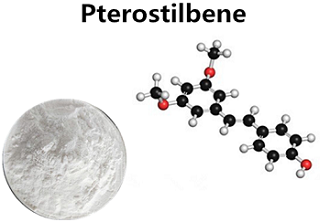Pterostilbene in Cancer Therapy
General Description
Pterostilbene, a polyphenol compound found in blueberries and grapes, has shown potential as a cancer therapy agent. However, its pharmacokinetics are complex. Orally-administered Pterostilbene undergoes rapid conjugation in the intestinal tract, limiting its effectiveness except in gastrointestinal tumors. Alternative administration methods like intravenous injection and topical application to cutaneous cancers have been explored. Pterostilbene has exhibited potent anticancer effects against breast cancer, inhibiting cell proliferation and increasing apoptosis. It has also shown efficacy against cervical cancer, inducing cell cycle arrest, apoptosis, and reducing migration. Pterostilbene holds promise as a potential therapeutic agent for the treatment of both breast and cervical cancers, targeting key oncogenic proteins and cancer stem cells.

Figure 1. Pterostilbene
Pharmacokinetics
Pterostilbene, a polyphenol compound found in blueberries and grapes, has shown potential as a cancer therapy agent. However, its pharmacokinetics, or how the body processes and absorbs it, are complex. When administered orally, Pterostilbene undergoes rapid conjugation in the intestinal tract, with very little of the free chemical structure reaching the systemic blood circulation. This limits the effectiveness of orally-administered Pterostilbene, except in primary tumors of the gastrointestinal tract. Alternative administration methods include intravenous (i.v.) injection and topical application to cutaneous cancers. When administered i.v., Pterostilbene levels in plasma peak five minutes after administration before rapidly decreasing, and tumor levels remain low. Topical administration, on the other hand, completely prevents chronic UVB-induced skin carcinogenesis. This suggests that the anticancer activity of Pterostilbene is not due to its direct antioxidant activity, but instead involves the maintenance of skin antioxidant defenses and inhibition of UVB-induced oxidative damage. Overall, Pterostilbene's potential efficacy as a cancer therapy agent is tempered by its limited bioavailability under in vivo conditions. 1
Anticancer Effects
Breast Cancer
Pterostilbene has been found to exhibit potent anticancer effects against various subtypes of breast cancer. In particular, Pterostilbene was shown to inhibit cell proliferation and increase apoptosis in MCF7 and ZR-751 breast cancer cell lines when used in combination with tamoxifen. An additive effect was observed in the reduction of cell viability in the ZR-751 cell line. However, MCF7 cells were found to be resistant to Pterostilbene due to high levels of HSP70 expression. Pterostilbene was also effective against mutant p53-breast cancer cell lines, where it decreased mutant p53 protein expression and increased pro-apoptotic Bax protein expression. In mouse models of breast cancer, oral administration of Pterostilbene suppressed tumor growth and induced apoptosis in ER-α66 negative cells through inhibition of Erk and Akt activation. Pterostilbene was also found to inhibit the invasive ability of MDA-MB-231 and Hs578t cells and suppress tumor growth and metastasis in an MDA-MB-231 xenograft mouse model through reduction in src expression. Additionally, Pterostilbene in combination with Vitamin E inhibited tumor growth and invasion in a breast cancer xenograft model through inhibition of Akt and down regulation of cell cycle proteins. Further investigation into the potential mechanism of Pterostilbene antitumor activity using the MDA-MB-468 cell line revealed an inhibition of Akt and an upregulation of Bax protein. These findings suggest that Pterostilbene may hold promise as a therapeutic agent for the treatment of breast cancer. 2
Cervical Cancer
Pterostilbene has demonstrated significant anticancer activity against cervical cancer. In both HeLa adherent and stem-like cells, Pterostilbene (20 and 40 µM) inhibited growth, viability, and migration. It achieved this by inducing cell cycle arrest through p53 upregulation and reducing the expression of cyclin E1 and cyclin B1. Pterostilbene also induced apoptosis by activating caspase-3 and caspase-9 through the generation of reactive oxygen species (ROS). It further downregulated antiapoptotic proteins (Bcl-2 and Bcl-xL) and inhibited the expression of MMP-2 and MMP-9. This study also investigated the effects of Pterostilbene on cervical cancer stem cell-like cells (CSCs). Pterostilbene suppressed the ability of CSCs to form tumor-spheres and migrate by reducing the expression of stemness supporting transcription factors (Sox2, Oct4, and Nanog) and inhibiting STAT3 activation. In another study, Pterostilbene was found to be cytotoxic to HPV-E6 positive cervical cancer cells by reducing the expression of the E6 oncoprotein. In a mouse xenograft model, intralesional injection of Pterostilbene significantly reduced tumor size by an average of 72% compared to controls. Immunohistochemistry analysis showed increased apoptosis through caspase-3 activation and reduced E6 expression in Pterostilbene-treated tumors. These findings suggest that Pterostilbene holds promise as a potential therapeutic agent for cervical cancer treatment, targeting both cancer cells and CSCs while reducing the expression of key oncogenic proteins. 3
Reference
1. Ferrer P, Asensi M, Segarra R, Ortega A, Benlloch M, Obrador E, Varea MT, Asensio G, Jordá L, Estrela JM. Association between pterostilbene and quercetin inhibits metastatic activity of B16 melanoma. Neoplasia. 2005 Jan;7(1):37-47.
2. Obrador E, Salvador-Palmer R, Jihad-Jebbar A, et al. Pterostilbene in Cancer Therapy. Antioxidants (Basel). 2021;10(3):492.
3. Shin HJ, Han JM, Choi YS, Jung HJ. Pterostilbene Suppresses both Cancer Cells and Cancer Stem-Like Cells in Cervical Cancer with Superior Bioavailability to Resveratrol. Molecules. 2020 Jan 6;25(1):228.
You may like
Related articles And Qustion
Lastest Price from Pterostilbene manufacturers

US $0.00/KG2025-03-11
- CAS:
- 537-42-8
- Min. Order:
- 2KG
- Purity:
- 99% up
- Supply Ability:
- 20 tons

US $0.00/Kg/Bag2025-03-11
- CAS:
- 537-42-8
- Min. Order:
- 1KG
- Purity:
- 99%min HPLC
- Supply Ability:
- 100kgs





